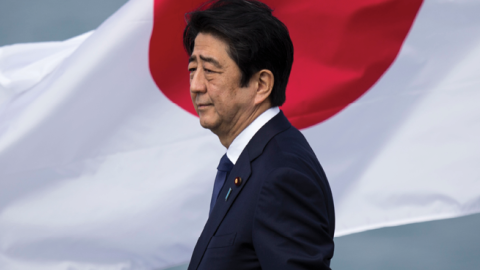Over the past 75 years, various visions of international order have been advanced, from George Kennan’s “long telegram” at the outset of the Cold War to George HW Bush’s “New World Order” at the end of that era.
Now, at the end of the Post-Cold War era, the world’s strategic focus has increasingly been shifting to the Indo-Pacific, recognizing that the future of the region will significantly shape the evolving international order.
Overwhelmingly, strategists have looked to the United States to articulate an Indo-Pacific strategy. Yet, in doing so, they have largely overlooked the strategic foresight and foundational role that Japan has played, starting with the late former Prime Minister Shinzo Abe, in defining and shaping key elements of today’s Indo-Pacific order.
Early Manifestations
The first Abe government took office in September 2006. In December of that year, Foreign Minister Taro Aso, in remarks to the Japan Forum on International Relations titled “The Arc of Freedom and Prosperity: Japan’s Expanding Diplomatic Horizons,” set out principles of governance to shape the emerging international order:
- The market economy
- Freedom
- Democracy,
- The rule of law
- Basic human rights
Aso’s “Arc” ran from Northern Europe through Eastern Europe, the Middle East, Central and South Asia, Southeast Asia, and extended to Northeast Asia, with Australia and New Zealand on the periphery.
Observers widely interpreted Aso’s remarks, in particular his emphasis on values, as a counterpoint to China’s proposal for an East Asian Community based on the Association of Southeast Asian Nations (ASEAN) plus China, Japan, and South Korea. Notably, Beijing excluded the United States, Australia, New Zealand, and Canada.
Confluence of Two Seas
Eight months later, in August 2007, then-Prime Minister Abe, in remarks to the Parliament of India known as “The Confluence of the Two Seas,” observed that the Pacific and Indian Oceans “are now bringing about a dynamic coupling as seas of freedom and of prosperity…. A ‘broader Asia’ that broke away geographical boundaries is now beginning to take on a distinct form.”
Abe expanded the Arc of Freedom and Prosperity to include the United States and Australia, in a region that would “share fundamental values such as freedom, democracy, and the respect for basic human rights as well as strategic interests.”
After returning to office in 2012, Abe revisited the Confluence of the Two Seas. In his address to the Sixth Tokyo International Conference on African Development, he committed Japan to “fostering the confluence of the Pacific and Indian Oceans and of Asia and Africa into a place that values freedom, the rule of law, and the market economy, free from force or coercion.”
Evolving Quad
In the interim, Abe in his December 2012 article “Asia’s Democratic Security Diamond,” advanced a strategic concept that has evolved into today’s Quadrilateral Security Dialogue (the Quad). Referring to his Confluence of the Two Seas remarks, Abe reiterated his conviction that “peace, stability, and freedom of navigation in the Pacific Ocean are inseparable from peace, stability, and freedom of navigation in the Indian Ocean.”
He expressed concern that China’s growing presence in the South China Sea threatened to transform the region into “Lake Beijing.” Admitting that in 2007 he failed to anticipate the pace of “China’s naval and territorial expansion,” Abe envisaged “a strategy whereby Australia, India, Japan, and the US state of Hawaii form a diamond to safeguard the maritime commons stretching from the Indian Ocean region to the western Pacific.”
Europe’s Commitment
Looking farther down the road, Abe invited the United Kingdom and France “to stage a comeback in terms of participating in strengthening Asia’s security.”
This, too, has come to pass.
In 2018, French President Emmanuel Macron proposed a strategic axis of France, India, and Australia to provide balance to the region. The United Kingdom in 2021, recognizing the growing challenges posed by China to British values and interests, announced its “tilt” to the Indo-Pacific, underscored by the deployment of the Queen Elizabeth Carrier Strike Group to the region.
Meanwhile, the United States, Australia, India, ASEAN, as well as France, the UK, the Netherlands, and the European Union have released Indo-Pacific strategies that emphasize the fundamental values and interests of the Free and Open Indo-Pacific:
- The rule of law
- Freedom of navigation
- Opposition to the use of force or coercion to change the status quo
On March 3, 2022, Quad leaders met to discuss Russia’s invasion of Ukraine. They also used the occasion to reaffirm their commitment to a Free and Open Indo-Pacific, and, with Taiwan clearly in mind, to respect for “sovereignty and territorial integrity, free from military, economic, and political coercion.”
Following the meeting, Prime Minister Fumio Kishida added: “We’ve agreed that unilateral change in the status quo like this should not be allowed in the Indo-Pacific. We’ve also agreed that this development makes it even more important to work toward realizing a free and open Indo-Pacific.”
Peaceful Change and the Status Quo
Kishida’s formulation has since been adopted by the Biden administration and other Western allies. Subsequently, United Kingdom Foreign Secretary Liz Truss told the Atlantic Council that “conflict anywhere threatens security everywhere. The Euro-Atlantic and Indo-Pacific are indivisible.”
At the June 2022 International Institute for Strategic Studies (IISS) Shangri-la Dialogue, Prime Minister Kishida focused his keynote address on challenges to rules-based international order. Voicing his concern that “Ukraine today may be East Asia tomorrow,” he outlined his vision of Japan’s role in shaping the future of a Free and Open Indo-Pacific — a commitment to pragmatic realism.
In brief, he called for “substantial” increases in Japan’s defense spending, a stronger Japan-US alliance, and enhanced security cooperation with like-minded countries, thereby reinforcing deterrence. Kishida committed Japan to enhancing diplomatic engagement across the region, with ASEAN and the Pacific Island countries, while expanding Japan’s foreign aid presence. The Japanese PM pledged to release by next spring a “Free and Open Indo-Pacific Plan for Peace” aimed at strengthening Japan’s contribution to the region.
It is now time to give credit where credit is due — to an overlooked Japan that has conceptualized and advanced the strategic concept of a Free and Open Indo-Pacific and brought along key allies and partners to support its strategic vision.

















